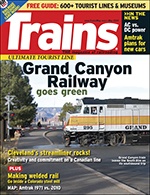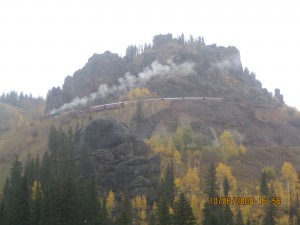It’s 8:50 pm on a Tuesday night, pitch black outside our train car as we speed southeast across Illinois, whistle moaning, just beyond the lights of springfield, on the train whose name comes from that city’s most famous citizen: the Lincoln Service, between Chicago and St. Louis. This is a train that Fred Harvey himself took often—probably even when Lincoln was still alive—and a route that defined the western frontier of big-city life before the country and its railroads began expanding west after the Civil War. Diane and I are here on the first leg of the train book tour we always dreamed about doing during those many, many, many years she was frediting and I was rewriting Appetite for America.
We just finished two busy, dizzying days in Chicago, starting with the book launch party at the Chicago History Museum—where we met not only a lot of Harveys, but quite a few same-name descendants of other Chicago legends who populated Fred’s world (such as hotelier Potter Palmer, whose top chef Fred swiped for the boutique restaurant/hotel in tiny Florence, KS that first cemented his international culinary reputation.) They combined our event with the dedication of the handsome new Guild Room, so we had a wonderful turnout of well over 100 people—even though we were up against the NCAA final. They served hors d’ouevres inspired by recipes in the book, including little cups of mac n’ cheese, grilled cheese sliders (very post-modern comfort food), little thimbles of rissoto topped with spicy shrimp, all delicious and served by waitresses not exactly sure why they were wearing conductors hats, but amused nonetheless. I gave a talk using pictures from the book and photos I took of Fred’s actual datebooks and stuff before I had to give them back to the Harveys, who graciously loaned me Fred and Ford’s belongings for many years.
After the event, Daggett Harvey, Jr, great-grandson of Fred, drove us back to our hotel—the Ambassador East, home of the famed Pump Room. Just days before we arrived the hotel had been sold to Ian Schrager, who I’m certain will do something extraordinary with it. But, in the meantime, the staff has been left in an unenviable state of hospitality limbo. They took great care of us, I must say, at an almost “Mr. Gladstone” level of familiarity and service, but there was a bit of a Dead Bellman Walking vibe in the place, and we were the only customers of the once vaunted Pump Room, where the staff outnumbered us. I hope Schrager does save the place, and that all the people who took care of us there get to be part of the institution’s glorious future. A good hotel staff is a terrible thing to waste.
The big evening event was followed today by a more intimate lunch for 35 at the Chicago Club, where George Pullman and all the top Chicago railroaders were early members (and, of course, a Pullman descendant was at the lunch.) Daggett, our host for the lunch, presented me with my own Chicago Club tie (which I am told either gets me into the club whenever I want, or gives me magic powers, or both), and then just blew me away with a gift from his own family collection of Harvey memorabilia. He presented me with one of Fred Harvey’s actual etched champagne glasses. It’s exquisite (the phone pic below doesn’t do it justice) and I immediately had it shipped home for fear I would break it during one of the many train rides we’ll be on in the next weeks.
After lunch I was interviewed by the immortal Milt Rosenberg at WGN, and then we headed to Union Station. The Amtrak bowels of the station are crazy crowded, but unlike Penn Station in New York, all the people are nice. We were herded onto train 305, sent to the clean, well-lit car going all the way to St. Louis, and settled back to watch Chicago, and then northern Illinois pass as the sun fell over the still very marshy and mushy Midwest. We bought a couple of Coronas at the well-stocked bar (not much food, but quite a few imported beers … priorities), and enjoyed the fading daylight with our incredibly diverse fellow passengers: I’ve only overheard one cell-phone conversation in English. My favorite image was an Eastern European young man, very Chekov (Star Trek, not theater), traveling with his young blonde son. When I went to the bar, he was sitting stone-faced with a brightly colored sticker his kid had just planted on his forehead. When I returned from the bar, he was still sitting with the same blank look on his face, and now a second sticker was on his left cheek.
I love the America that reveals itself on the trains—just as it always has.

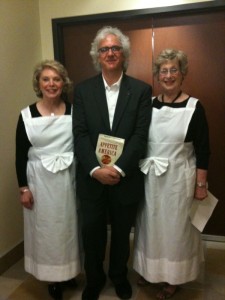

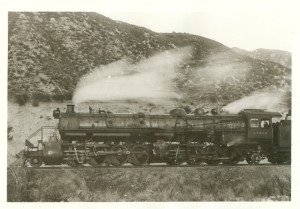
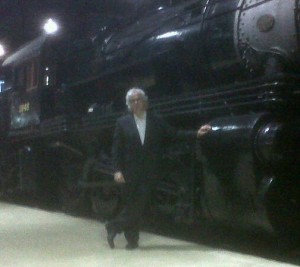
 BTW, your book “Husbandry” was so entertaining and insightful! FYI, our cat “Harvey” has a new nickmame: Fred.
BTW, your book “Husbandry” was so entertaining and insightful! FYI, our cat “Harvey” has a new nickmame: Fred.